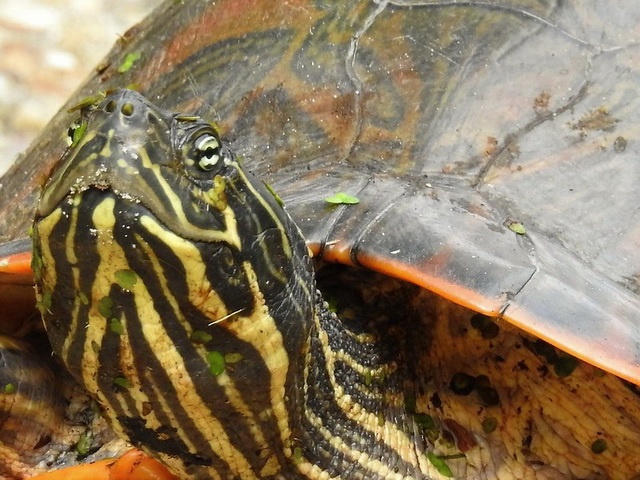Older painted turtle male switches to violent behaviour
During their life, painted turtle males change their behaviour towards females. They switch from courtship to coercion, Patrick Moldowan and colleagues witnessed.
Mating is often a pleasant affair in the painted turtle, Chrysemys picta. A male courts a female and at one point he strokes her head with his fore claws, which are elongated in males. If she is receptive, things go on. This state of affairs was known.
But males are not always that friendly, according to Patrick Moldowan and colleagues, who study the animals in wetlands in Canada. They had noticed that during the breeding season, in late summer, many females have bite wounds on head and neck. Apparently, males can become outrageous and bite, they write. They wanted to know more.
Claws or teeth
As it turned out, the tactic with which a painted turtle male approaches a female depends on his size, and thus on his age. The researchers discovered this by temporarily enclosing animals, after measuring their size, in a cage in their living environment. They videotaped their behaviour and watched the footage afterwards. Young adult men are gallant lovers, they saw. Their fore claws are very elongated. But as males get older and grow, their fore claws don’t. As a result, they are getting smaller in proportion.
At the same time, males develop ‘weapons’. Two tooth-like cusps (tomiodonts) appear at the front of the upper jaw. In males, those teeth are much more prominent than in females, and when a male grows, his teeth get proportionally larger. In addition, projections develop on the anterior edge of his upper shell. Males use these weapons to force women into mating; they bite and they clatter with their shells.
So, males switch from a friendly to a violent attitude towards females during their lifetime; the relative size of claws, tomiodonts and carapace projections matches their behaviour.
Storage
A successful mating can result in many offspring; also in the long term, because a female stores the sperm for a long time. It therefore makes sense that a painted turtle male strives to get access to a female. But why do only small males this in a kind way? Perhaps because females, that are larger on average, would be able defend themselves well against unfriendly small males. It’s then better to be nice. But as males get bigger and stronger, coercion appears to be more successful.
Unfortunately, the researchers could not see whether large males were really able to enforce mating, because the animals didn’t go so far during the experiments.
Willy van Strien
Photo: Rickard Holgersson (via Flickr, Creative Commons, Public Domain)
Sources:
Moldowan, P.D., R.J. Brooks & J.D. Litzgus, 2020. Sex, shells, and weaponry: coercive reproductive tactics in the painted turtle, Chrysemys picta. Behavioral Ecology and Sociobiology 74: 142. Doi: 10.1007/s00265-020-02926-w
Moldowan, P.D., R.J. Brooks & J.D. Litzgus, 2020. Demographics of injuries indicate sexual coercion in a population of Painted Turtles (Chrysemys picta). Canadian Journal of Zoolology 98: 269-278 Doi: 10.1139/cjz-2019-0238
Hawkshaw, D.M., P.D. Moldowan, J.D. Litzgus, R.J. Brooks & N Rollinson, 2019. Discovery and description of a novel sexual weapon in the world’s most widely-studied freshwater turtle. Evolutionary Ecology 33: 889-900. Doi: 10.1007/s10682-019-10014-3
